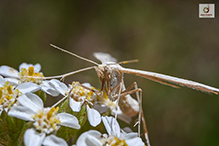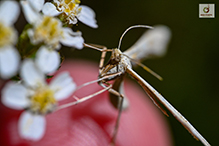plume moths
(subfamily Pterophorinae)
Overview • Description • Distribution • Taxonomy
Description |
Pterophorinae range in size from the minute plume moth (Pterophorus pentadactyla), with a wingspan of just 3⁄16″ (5 mm), to the giant plume moth (Megalorhipida leucopterus), with a wingspan of 1 3⁄16″ (30 mm). The body is slender and brownish, gray, or white. The antennae are long. The legs are long, slender, and sometimes spiny. On the hind leg, the fourth segment (tibia) is two to three times longer than the third segment (femur). The forewings are deeply notched at the tip, dividing the wing into two lobes. The hindwings are deeply divided into three lobes. The lobes of the hindwing are often fringed with long, sometimes curved filaments, giving the lobe a plume-like appearance resembling a bird’s feather. |
Distribution |
||
|
Sources |
|
| 6/23/2025 | ||
Occurrence |
||
|
||
Taxonomy |
|
Order |
|
Superfamily |
Pterophoroidea (Plume Moths and Allies) |
Family |
Pterophoridae (Plume Moths) |
Subordinate Taxa |
|
Tribe Marasmarchini Tribe Oidaematophorini Tribe Oxyptilini Tribe Platyptiliini Tribe Pterophorini Tribe Tetraschalini |
|
Synonyms |
|
|
|
Common Names |
|
This subfamily has no common name. The common name of the Family Pterophoridae is plume moths, and it is applied here for convenience. |
|
Glossary
Femur
On insects and arachnids, the third, largest, most robust segment of the leg, coming immediately before the tibia. On humans, the thigh bone.
Tibia
The fourth segment of an insect leg, after the femur and before the tarsus (foot). The fifth segment of a spider leg or palp. Plural: tibiae.
Visitor Photos |
||
Share your photo of this insect. |
||
This button not working for you? |
||
Mike Poeppe |
||
 |
 |
|
Alfredo Colon |
||
 |
 |
|
MinnesotaSeasons.com Photos |
||
|
||
|

Slideshows |
|

Visitor Videos |
||
Share your video of this insect. |
||
This button not working for you? |
||
|
Other Videos |
||
|

Created: 7/16/2023 Last Updated: © MinnesotaSeasons.com. All rights reserved. |



